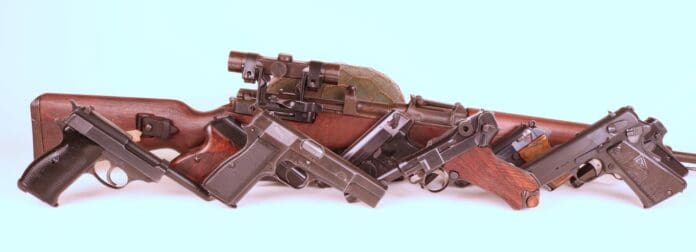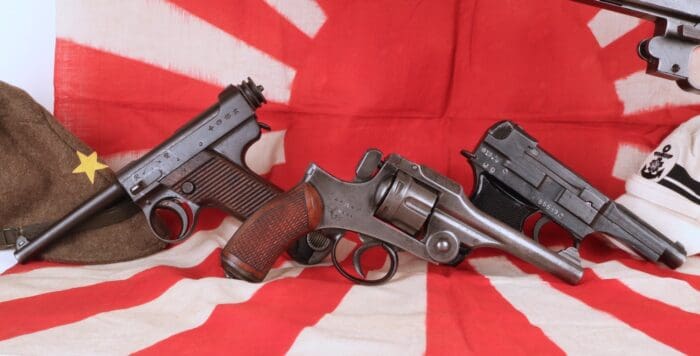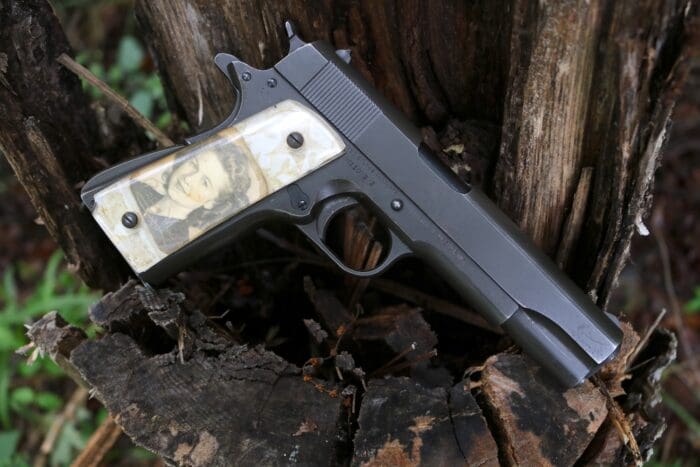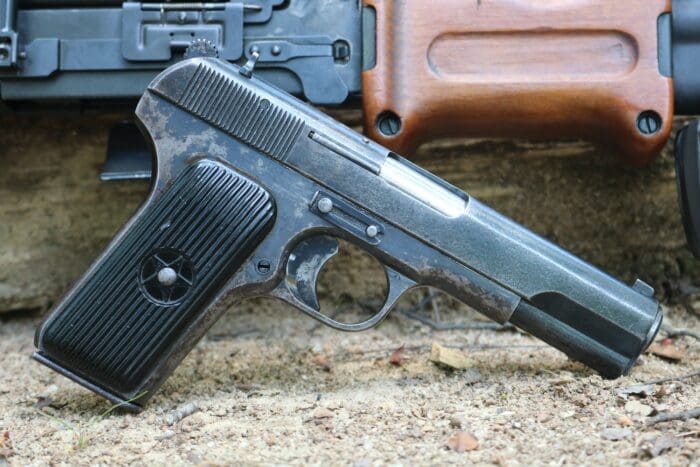
Rivers of ink have been spilt over that simple query: what was the best combat handgun used in WW2? With virtually the entire planet aflame, each combatant country threw their everything into military production. The end result influences the tactical landscape to this day. So, let’s take a look at what each country did that is notable in the realm of handgun development during the big one.
Japan

I think we can all agree that they sucked the most. Most officers bought their own sidearms, so there was a great deal of variation in the field. The Type 14 Nambu was decent though underpowered. The Type 94 was an abomination. The magazine floorplate was not positively retained, so the thing had a nasty habit of ejecting its magazine spring at inopportune moments. The grip tapered from top to bottom, so it always feels like the gun is about to squirt out of your hand when you gripped it hard. And then there is the exposed sear bar such that the weapon would go off if you squeezed the sides or set it down vigorously on an uneven surface.
All that pales in comparison to the Type 26 revolver. The Type 26 is beautifully executed but hopelessly flawed. The lockwork inexplicably opens up for maintenance, as though that was actually a thing. The unforgivable sin, however, was that the cylinder was not positively retained. Fire a round or two, move about vigorously, and the gun may or may not be ready to index to a hot chamber when needed. Wow!
United States

The origin story of the Colt M1911A1 .45 pistol should be foundational dogma to all of us by now. Like the country that made it, the 1911 was big, heavy, loud and mean. The single-action trigger meant it could not be safely carried with a round in the chamber and the hammer down, but that same trigger had such a sweet personality. The 230-grain .45 ACP bullet was fully twice as massive as its European 9mm counterparts. Some might complain about the gun’s ample size and mass, but they are all losers. Tens of thousands of dead enemies would attest to that.
England

The Webley and Enfield revolvers were some of the finest wheelguns used during WW2, but they still reflected yesterday’s technology. The chamberings were relatively anemic, and you still had to fumble with individual cartridges to keep the guns fed. That’s no mean feat under fire. However, these were some sweet-shooting revolvers, and they were rugged as tire irons.
Russia

The TT33 Tokarev was another Browning design that would honestly make a better concealed carry pocket gun than a service pistol. The small-caliber, high-velocity 7.62x25mm round was lightyears ahead of its time, but the gun lacked a manual safety, so there’s that. However, it was just the ticket for shooting some poor shmuck in the back of the nugget when he didn’t feel like charging German MG42’s.
The M1895 Nagant pistol was more complicated than the human female and fired a weird telescoped round that was way more complex than was necessary. The design cammed the cylinder forward to form a tight gas seal over the barrel at the moment of firing, but that was utterly superfluous. The Nagant would have been a novelty in WW1. By WW2, it was just sad.
Germany

The krauts fielded dozens of different pistols, a great many of which were chambered for .32 ACP. That the same guys who brought us the Tiger tank could issue such pathetic little handguns is a vexing question for the ages. However, we will focus our attention on the P08 Luger and the P38.
Designed based upon inspiration from the human knee joint, Georg Luger’s P08 Parabellum was hands-down the most elegant handgun of the war. It was also the alpha souvenir for GI’s wishing to impress their girlfriends and younger siblings back home. However, the exposed nature of the action made it susceptible to fouling, and the trigger kind of sucked unnecessarily.
The Walther P38 was arguably the most advanced pistol design of WW2, but its single-stack eight-round magazine was underwhelming. Additionally, the heel-mounted magazine release kept the gun from reaching its full tactical potential. However, the single-action, double-action trigger inspired an entire generation of wonder nine pistols, and the gun was likely the safest of the lot to carry and get into action quickly.
My Fave
The Browning Hi-Power was certainly a player, too, but there never were very many of those, relatively speaking. However, in the final analysis, who cares? Handguns don’t win wars. Trucks do—or other transport does—as you have to get soldiers into the fight before what they are toting really matters. A soldier’s pistol, however, is oftentimes his most intimate personal possession, though it is vanishingly rare that he actually has to use it.
In the final analysis, I am partial to the M1911A1 myself, but I am unashamedly biased. That thing was a beast. However, truth be known, had we never issued a single combat handgun, we still would have won the war. Nuclear weapons and thousand-bomber raids made sure of that. Regardless, it is a timelessly enjoyable exercise to pick apart the details of all the handguns made during that crazy time in history, and see who, even today, comes out on top.




The Germans were issuing .32 acp because they were handgun hogs. hitler militarized the country. Meter readers, mailmen and other ‘civilian’ jobs had uniforms and sidearms. Thousands of clerk typists that were ‘civilian’ employees were sent to occupied coun tries to help with bean counting. They got sidearms. ‘Civilian’ party members, like mayors, got sidearms.
Blowback .32’s were simply easier to produce. Frontline troops got 9’s.
If I was forced to pick a milsurp from ww2 it would be the 1911. Cause Murica.
I’m going for an S&W Victory Model or an M1917 revolver personally if I don’t go for the Hi-Power. If you’re going to do 9mm may as well have the capacity too. Some of the Radom produced pistols are also a nice choice IMO. A Radom Vis 35 would be another choice as well for semi auto.
At least someone else was thinking of the Polish Radom pistol. It should have had at least an honorable mention.
And Ian McCollum is asking why no .32 French Long.
My first thought was obviously the 1911, and then I remembered the Browning Hi-Power. I think I’d prefer the Hi-Power.
Don’t forget the old 1917 Colt and Smith revolvers in .45acp, though leftover from WW1 they were still used in WW2. Brad Pitt’s character in the movie “Fury” (2014) can be seen carrying one.
At right around 830fps mv for the standard .45acp ball, the 1911 doesn’t really live up to it’s potential. Modern SD ammo of the +p variety that is available adds considerable swagger to it, and in a carbine length barrel such as the new Ruger LC45 it’s a real ass kicker. I have both.
I also grew up with the 1911 starting age 11 in 1955, and carried one in my SE Asia adventures in the mid ’60’s, along with an M3 grease gun. So yeah, I’m partial to JMB’s original design. 🙂 Those other gats don’t even compare.
Model of 1911A1 .45 Automatic. 👍
The Tok is pretty cool but muzzle energy. The same or above a .45acp? I dont think so. I go on the whappem factor when it comes to handgunm partridges.
.45acp lays a lot of whappem out there when it hits.
To me the sexiest looking pistol is the p08, especially the Artillery Model. 9mm hard ball. Two shot wonders. No thanks.
Looking around on the web, I found a TT shooting 85gr at about 1345fps. Compared to 230gr 800fps ball which is 340ish ft-lbs vs 360-380. It’s not actually a horrid round at all honestly, especially compared to some .32 auto or .38 Special ammo.
9mm Luger is in the same ball park as well energy wise. Where I’d think the .45 would have the edge is ball ammo that doesn’t expand is automatically a bit bigger and less likely to go through something which means it’s more likely to transfer energy. Penetration and flat shooting wise? I’d go with either the Tok or the 9mm although that’s admittedly probably more of an SMG sort of quandry.
I shot a car rim with 9mm Luger and .45acp. The 9mm put a hole through it and the .45 cracked the rim and knocked the rim off the concrete holder block.
I’ve shot a lot of sht. Bookwork MV is figures on papers. Taylor’s Knockout theory is closer to the mark when it comes to handgunm cartridges.
The Colt was the ultimate ass-kicker for that war, but I must admit that I have always wanted a Browning Hi Power and a Luger P08, neither of which have I ever had the pleasure to shoot. 9mm is an adequate round for the intended purpose, which is a not to exceed range of 20 meters.
I had me a slicked-up Hi-Power and let it go when times got hard.
Get you one, you won’t regret it… 🙂
I had a Tok. The only safety is a half cock notch. No good. I had a 95 Nagant revolver. Weird little beast but back then milsurps were stupid cheap. Mine cost 70 bucks and the surplus ammo was cheap. I carried mine gold panning in the mountains. I did not sweat damaging it and if the cops took it? No big.
BIL has a bog standard P08. Good range gun but I would not want one in the wild.
This was meant as a reply to bro possum.
I’ve got a 54-1. Used to be my primary edc.
I Retired it as I think it will be a somewhat of a collectible in the future I presumen.
One thing is a person gets quite a bit of firepower for the dimensions.
Half cock. I practiced a cowboy style hammer draw until I wasnt to slow, still not fast enough even being faster, trouble was I was shredding palm flesh to get to the speed you’d need.
One of the furthest pistol shots I’ve made was with that 54-1, a Blue Heron at around 250 yards, there ain’t much to a Blue Heron but feathers. 7.62×25 a pocket rocket, but when it comes to thumpem, 45 hands down
M1911A1 can’t safely carry a round in the chamber? If that’s the case there are too numerous to count ND’s waiting to occur. That’s exactly the way that JMB designed it. That’s why there is a thumb- and grip safety. And, if dropped in Condition 1, there is a massive, hooked half-cock notch to stop and capture the hammer.
Delete above. Should’ve had my reading glasses on. Missed the “can’t be carried with a loaded chamber AND the hammer down”.
Overall I would vote for the 1911 pistol as the “best” combat handgun of World War II.
Having said that, I do not believe that it was an excellent choice simply because it was larger and heavier than necessary. (Remember: soldiers want their load-out to be as small and light as possible.) Unfortunately, I am not aware of any other handgun at the time that would have been equally reliable while also being smaller and lighter.
The 1911A1 ruled the roost for a pure fighting pistol. The Hi-Power is a distant second. Primarily because it’s a poor man stopper with ball ammunition. Luger gets the nod for panache. P-38, for all its “innovation” was an answer looking for a question. The DA/SA is still searching. There’s no question about the revolvers. M 1917. I prefer the S&W, but nothing wrong with a good Colt. The Russian stuff was serviceable, but it usually is and that’s about all you can say about that.The Japanese handguns were laughable and that’s about all you can say about that.
No love for the Polish Vis 35 (Radom)?
That’s most unfortunate.
Rick, it’s not that there’s no love. It’s where does the list end?
Exactly! It had a decocker IIRC, so one in the tube with magazine release by the trigger guard.
BEACUSE this is TTAG, and that I am a long time reader and infrequent contributor, I will add a justified comment. A +, and a – if you will.
Our dear author must be of an older age in that he used the common vernacular slur of “The krauts…” without the decency to capitalize the “K”.
My incredibly loving & giving German grandmother would disapprove.
Golly, it’s the year of our Lord 2024, please buy a clue.
He also brilliantly mentions that “…truck & transportation wins wars…”, which was also very true and insightful. I use past tense because in this digital age we all know that attacks on our power grid, food distribution & communications systems will be the first volleys, and could most likely preemptively win a war before the bodies pile up.
YMMV
(If you haven’t paid attention to the trial runs over the last decade, well, just keep snoozing.)
I enjoy reading Dabbs but BS “thousand-bomber raids” – little result for the effort/expense. AirCorps/RAF mostly hit the ground. Somewhere. How little has changed in the decades.
Much more accomplished per 4/KIA by mediums performing air support – Mosquitos/etc.
The Mighty 8th were the daylight bombers. My father was a flight line mechanic in WWII.
Yes. They hit a lot of ground but also enough shit that mattered to the krauts. Lots more Americans died so they could more effectively hit their targets.
They were very effective compared to night bombers.
We did fight the krauts in WWII.
We now welcome the German people to do business with the world.
If hostilities ensue in the future, they would be krauts again.
“He also brilliantly mentions that “…truck & transportation wins wars…”, which was also very true and insightful.”
I have to disagree, it was one thing and one thing only over a broad spectrum, it was a sledgehammer manufacturing output that totally overwhelmed a multi-front enemy.
There’s a multi-episode PBS show from a book that covers it well, once that engine was turned on, nothing was gonna stop it. And the post-war economic boom was a direct result of the infrastructure and technology developments from wartime…
Just like today. The one you have in your hand when you need one.
Personally I’d vote for Gen. Patton’s brace of nickel plated Peacemakers, but in lieu of them I’d go with the 1911 or M1917 just because I think the.45 acp is the best option with fmj ammo.
Only one of Patton’s revolvers was a .45SAA. He had two but gave one to a friend. The other revolver he carried was one of the early .357 Magnums
Ooo… even better.
Patton would have carried a Smith 29 had one been available then… 😉
Colonel Ludmilla Leonovna had a handgun that fired the equivalent of tactical nuclear weapons which she utilized to kill The Apocalypse Troll.
I know a Ludmilla, she goes by “Luby”…
How does she look when wearing only a to short to be decent sweater?
Quite pleasant, actually, she’s from Slovakia, a city called Tranava.
Her husband says the only thing she makes for dinner well is reservations.
Her hubby jumped the iron curtain in the late 80s…
Of the WWII weapons available at the time, I would hands down pick the 1911A1. But, being an old US Army grunt and son of a WWII veteran I am a bit biased.
I have and shoot most of the WWII side arms. Don’t have a Nambu in current collection but have had them.
Now. of the 9mm weapons, in order of preference would be 1 the Browning HP,2. the Walther P-38, and 3. the Luger P-08. All fine weapons. The Tokarev is functional but that’s about all. As with most Soviet Russian equipment, as crude and basic as a hammer.
The various revolvers are mostly secondary issue or whatever was available on any given day. Good weapons, some very well designed and manufactured, but a bit outdated by 1938 and bordering on obsolete by 1941.
1911
1911. Rarely mentioned is its stellar safety record – l can’t prove it with hard data, but posit that it is the safest pistol design, especially in a working environment.
No contest…1911
The one that saved your life.
The Beretta 34 (.380) and 35 (.320) should deserve some attention, too.
I’d stretch the definition and go with the MP-40 – no stock or even a brace – so must be a pistol, no?
MP40 absolutely has a [spindly wire] stock. Even the repros legally sold as “pistols” have a fixed-folded stock.
‘Best’ Is relevant,
I’d say the handgun(s) that killed the most people in WW2 would probably have been the 9mm Lugers, wielded by the German’s.
They killed Millions with them. Probably half were non-combatants and a fair percentage were their own people right there at the end, not to mention the Jews.
The Savage 1907 finished a close 2nd to the Colt in trials for the military contract. It was later the first handgun marketed specifically toward women.
M 1911 A1 .45
Good job Will!
The Inglis High Power was still in use with our Canadian allies in Afghanistan until very recently. The Tokarev is overlooked, the right fun at the right time for the Reds.
The .38s and the Japanese guns were a joke. Hard to believe Nambu designed such excellent light machineguns and such a poor pistol.
A good read
Comments are closed.